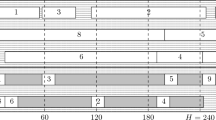Abstract
Chemotherapy planning and patient–nurse assignment problems are complex multiobjective decision problems. Schedulers must make upstream decisions that affect daily operations. To improve productivity, we propose a two-stage procedure to schedule treatments for new patients, to plan nurse requirements, and to assign the daily patient mix to available nurses. We develop a mathematical formulation that uses a waiting list to take advantage of last-minute cancellations. In the first stage, we assign appointments to the new patients at the end of each day, we estimate the daily requirement for nurses, and we generate the waiting list. The second stage assigns patients to nurses while minimizing the number of nurses required. We test the procedure on realistically sized problems to demonstrate the impact on the cost effectiveness of the clinic.





Similar content being viewed by others
References
Le cancer. https://www.societederecherchesurlecancer.ca/page.aspx?pid=2093
Interview with members of the managerial team at the chemotherapy clinic of Notre-Dame hospital. Personal communication (2016)
Alvarado M, Ntaimo L (2016) Chemotherapy appointment scheduling under uncertainty using mean-risk stochastic integer programming. Health Care Management Science. https://doi.org/10.1007/s10729-016-9380-4
Berwick DM, Nolan TW, Whittington J (2008) The triple aim: care, health, and cost. Health Aff 27 (3):759–769
Condotta A, Shakhlevich N (2014) Scheduling patient appointments via multilevel template: a case study in chemotherapy. Oper Res Health Care 3(3):129–144
Dobish R (2003) Next-day chemotherapy scheduling: a multidisciplinary approach to solving workload issues in a tertiary oncology center. J Oncol Pharm Pract 9(1):37–42
Gocgun Y, Puterman ML (2014) Dynamic scheduling with due dates and time windows: an application to chemotherapy patient appointment booking. Health Care Manag Sci 17(1):60–76
Green E, Preyra C, Stewart J, McLennan C, Bland R, Dus T, Langhorn M, Beattie K, Cheung A, Hertz S, Sechter H, Burns J, Angus H, Sawka C (2012) . Determining resource intensity weights in ambulatory chemotherapy related to nursing workload 22:114–28
Hahn-Goldberg S, Carter MW, Beck JC (2012) Dynamic template scheduling to address uncertainty in complex scheduling problems: a case study on chemotherapy outpatient scheduling. In: Society for health systems conference. Las Vegas
Lamé G, Jouini O, Stal-Le Cardinal J (2016) Outpatient chemotherapy planning: a literature review with insights from a case study. IIE Trans Healthcare Syst Eng 6(3):127–139
Liang B, Turkcan A, Ceyhan ME, Stuart K (2015) Improvement of chemotherapy patient flow and scheduling in an outpatient oncology clinic. Int J Prod Res 53(24):7177–7190
Sadki A, Xie X, Chauvin F (2010) Patients assignment for an oncology outpatient unit. In: 2010 IEEE Conference on automation science and engineering (CASE). IEEE, pp 891– 896
Sadki A, Xie X, Chauvin F (2011) Appointment scheduling of oncology outpatients. In: 2011 IEEE Conference on automation science and engineering (CASE). IEEE, pp 513–518
Santibáñez P, Aristizabal R, Puterman ML, Chow VS, Huang W, Kollmannsberger C, Nordin T, Runzer N, Tyldesley S (2012) Operations research methods improve chemotherapy patient appointment scheduling. Joint Commission J Qual Patient Safe 38(12):541–553
Turkcan A, Zeng B, Lawley M (2012) Chemotherapy operations planning and scheduling. IIE Trans Healthcare Syst Eng 2(1): 31–49
Van Merode GG, Groothuis S, Schoenmakers M, Boersma HH (2002) Simulation studies and the alignment of interests. Health Care Manag Sci 5(2):97–102
Wong Kee Yan N (2017) Chemotherapy outpatient scheduling at the Segal Cancer Center using mixed integer programming models. Ph.D. thesis, Concordia University
Woodall JC, Gosselin T, Boswell A, Murr M, Denton BT (2013) Improving patient access to chemotherapy treatment at Duke Cancer Institute. Interfaces 43(5):449–461
Author information
Authors and Affiliations
Corresponding author
Appendices
Appendix A: Measure of hourly workload (\({G^{p}_{i}}\))
The CTC prepared a list of rules related to workload balancing. We use it to develop two parameters to facilitate the estimation of workload. The first, \({G^{p}_{i}}\) (Table 9), represents the hourly workload that the patient requires.
Appendix B: Linearization of the formulation
Constraints (1l) and (1m) are both nonlinear. We use a big-M approach to linearize them: Constraints (4a) and (4b) replace (1l), and Constraints (4c) and (4d) replace (1m). The parameter \({\Theta }_{i^{p}}\) plays the role of the big M; it is tightened as much as possible in each case.
Appendix C: Formulation of offline model
Variables
- \(x^{p}_{ifjh}\)::
-
1 if treatment ip of patient p is assigned to nurse f on day j in time slot h; 0 otherwise
- \({y^{p}_{i}}\)::
-
1 if treatment ip of patient p is assigned; 0 otherwise
- zfj::
-
1 if nurse f is assigned; 0 otherwise
- vfjh::
-
1 if nurse f is on break in time slot h; 0 otherwise
- τfj::
-
Integer variable: number of tasks handled, {0...E}
- σfj::
-
Integer variable: first overflow level, {0...B}
- ιfj::
-
Integer variable: second overflow level, {0...C}
Model
s.t.
Appendix D: Outline of the procedure to generate cancellations and absences
Rights and permissions
About this article
Cite this article
Benzaid, M., Lahrichi, N. & Rousseau, LM. Chemotherapy appointment scheduling and daily outpatient–nurse assignment. Health Care Manag Sci 23, 34–50 (2020). https://doi.org/10.1007/s10729-018-9462-6
Received:
Accepted:
Published:
Issue Date:
DOI: https://doi.org/10.1007/s10729-018-9462-6






